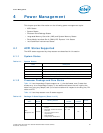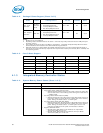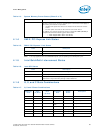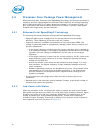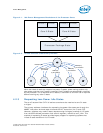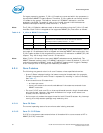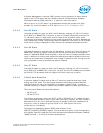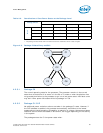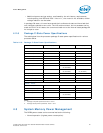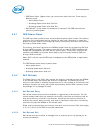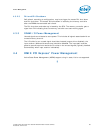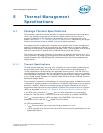
Power Management
94 Intel® Xeon® Processor E5-1600/E5-2600/E5-4600 Product Families
Datasheet Volume One
4.2.5 Package C-States
The processor supports C0, C1/C1E, C2, C3, and C6 power states. The following is a
summary of the general rules for package C-state entry. These apply to all package
C-states unless specified otherwise:
• A package C-state request is determined by the lowest numerical core C-state
amongst all cores.
• A package C-state is automatically resolved by the processor depending on the
core idle power states and the status of the platform components.
— Each core can be at a lower idle power state than the package if the platform
does not grant the processor permission to enter a requested package C-state.
— The platform may allow additional power savings to be realized in the
processor.
• For package C-states, the processor is not required to enter C0 before entering any
other C-state.
The processor exits a package C-state when a break event is detected. Depending on
the type of break event, the processor does the following:
• If a core break event is received, the target core is activated and the break event
message is forwarded to the target core.
— If the break event is not masked, the target core enters the core C0 state and
the processor enters package C0.
— If the break event is masked, the processor attempts to re-enter its previous
package state.
• If the break event was due to a memory access or snoop request.
— But the platform did not request to keep the processor in a higher package
C-state, the package returns to its previous C-state.
— And the platform requests a higher power C-state, the memory access or snoop
request is serviced and the package remains in the higher power C-state.
The package C-states fall into two categories: independent and coordinated. C0/C1/
C1E are independent, while C2/C3/C6 are coordinated.
Starting with the 2nd Generation Intel(r) Core(TM) Processor Family, package C-states
are based on exit latency requirements which are accumulated from the PCIe* devices,
PCH, and software sources. The level of power savings that can be achieved is a
function of the exit latency requirement from the platform. As a result, there is no fixed
relationship between the coordinated C-state of a package, and the power savings that
will be obtained from the state. Coordinated package C-states offer a range of power
savings which is a function of the guaranteed exit latency requirement from the
platform.
There is also a concept of Execution Allowed (EA), when EA status is 0, the cores in a
socket are in C3 or a deeper state, a socket initiates a request to enter a coordinated
package C-state. The coordination is across all sockets and the PCH.
Table 4-9 shows an example of a dual-core processor package C-state resolution.
Figure 4-3 summarizes package C-state transitions with package C2 as the interim
between PC0 and PC1 prior to PC3 and PC6.




